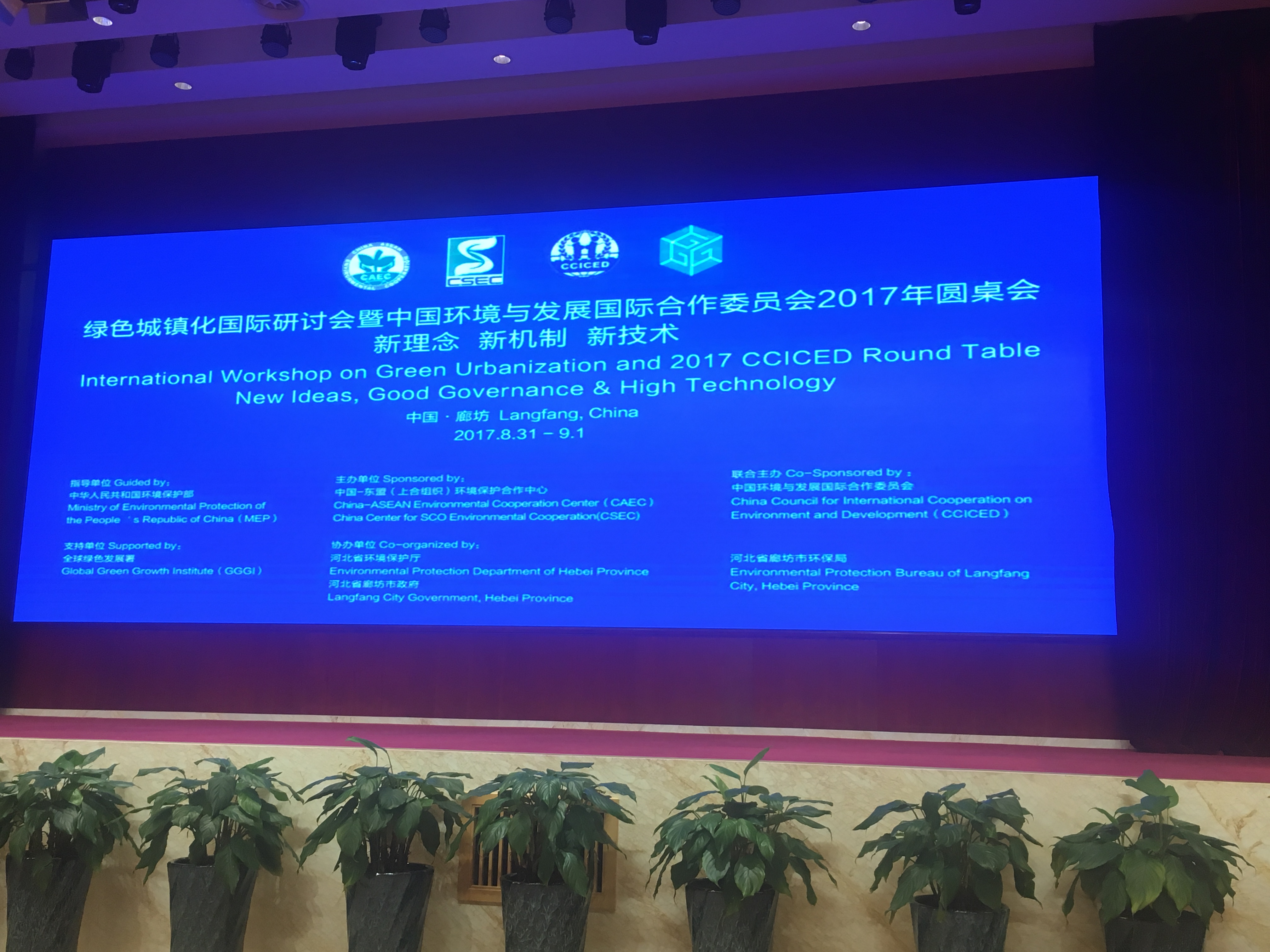Last week, I attended the International Forum on Green Urbanisation in Langfang, China, which was organized by the Chinese Ministry of Environmental Protection and the Green Global Growth Institute (GGGI).
Langfang is a satellite town of Beijing, approximately 90 minutes from the centrum of the Capital. It is part of the Beijing-Tianjin-Hebei urbanised region in Northern China, and has announced to become an eco-city. The Mayor of Langfang had invited the organisers to come to Langfang for an exchange of information and discussion of potential green urban development options.

MEP was represented by the China Council for International Cooperation on Environment and Development (CCICED), a major think-tank in China. We were invited by both CCICED and GGGI to participate in the Forum, and I had bilateral meetings with Guo Jing, Director-General of International Cooperation of the Ministry of Environment Protection and GGGI Director-General Frank Rijsberman to discuss closer cooperation.
The Forum involved a large number of national and international urban development experts, and the presentations covered energy, transport, urban development and more.

I was happy to provide one of the opening speeches, and stressed the possibilities of bamboo in urban development. I made the point that bamboo should be included in urban parks and green spaces, that bamboo can help mitigate carbon emissions from cities, that bamboo charcoal can be a sustainable source of household fuel and that bamboo can help with soil and water management. I also stressed that bamboo as a product can play a major role in interior design and construction. I believe that my ideas were well received.

One of the key speakers was CCICED Senior Advisor, and former Minister Liu Shijin, who presented economic facts and figures. He warned us that the economic downturn in China is real, and that we should not expect a major upturn after a few years. He reckons the downward spiral will bottom out next year at 5% growth, and that this will be the norm for many years to come. He promised long-term stability after 2018, but at a medium range economic growth, rather than the high growth experienced several years ago.
He also stressed that the main urbanization in China will continue to be focused in the three large metropolitan circles of Beijing, Shanghai and Guangdong.

Another presentation that provided an interesting perspective was that by Donovan Story, the GGGI Deputy Director and Global Lead on Green Cities. He reminded us that by 2050 more than 6 Billion people, or 70% of the global population, will live in cities.

He cited as main challenges in urban development the fact that there is still a divide between urban and rural societies, and urban areas are seen as sectors that focus on infrastructure. Instead, he advocated a Green City approach that is inclusive and looks at environmental, social and economic aspects of development. He called for smart, green and sustainable cities that improve energy efficiency and promote renewable energy; that close the waste/resource loop and improve access to clean water and sanitation; that are connected and walkable, pro-poor and inclusive.

After lunch, Professor Qi Ye from the School of Public Policy & Management of Qinghua University, reiterated the rapid urban growth, and warned that the rural population is actually starting to shrink. He also reminded us that 800 years ago, the Chinese Capital city had more than 1 million people, and in those days more than 20% of the population lived in urban areas.
Prof Qi showed how different energy sources have fueled the economic growth during the past decades. Starting with biomass and coal as the main power source, oil, gas, hydro and nuclear power are playing a more important role. In the big picture, other renewables hardly show up.

Finally, Prof Qi talked about the future, and he stressed that new urbanization is a combination of compact, green, smart and low carbon
Nicholas You from World Future Council talked about “from smart cities to sustainable regions”. He presented several very interesting case studies from around the world. This included the high-tech coordinated approach in Rio de Janeiro; the inclusive consultation processes in Bristol, UK and the integrated planning approach in Singapore. I was astounded to hear that Singapore recycles all it used water, and that excess run-off during rain storms is collected in a maze of wetlands, parks and smaller reservoirs.
Nicholas advocated that we should have one Key Performance Indicator for urban development, and he suggested this to be human health and welfare.

The third session, after tea break included a presentation by Marijn van der Wagt from the Dutch Ministry of Infrastructure and the Environment about the Dutch perspective. She stressed the consultative approach in the Netherlands, and explained that Dutch people are generally happy in small spaces. She also mentioned that there are more bicycles than people in the Netherlands!


Liu Kewei from INBAR gave a very interesting presentation about bamboo construction and how this can contribute to green urbanization. She showed examples of bamboo design and architecture from around the world, and made the case that there is an important role for bamboo. After all, bamboos are grasses, so any products manufactured from bamboo did not involve logging of timber and cutting of trees.


She also explained that INBAR is the Liaison Organisation for ISO Technical Committee 165 for timber structures. As Convener of the working group on structural uses of bamboo, INBAR has helped to develop national and local standards for bamboo construction in several countries.

There were many other presentations about rural heating, urban planning, energy assessments, and other interesting aspects, and I learned a lot. It is clear that the challenge to find ways in which to make future cities nice living spaces is enormous.
I hope that the examples provided during this interesting forum will help planners in China and abroad, and that urban planners, architects and designers will think about bamboo when they prepare their blue-prints.

0 comments
Write a comment